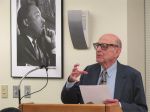Last year, New York City-based criminologist David Kennedy presented his model for reducing gang violence at the University of Pittsburgh School of Social Work Center on Race and Social Problems Summer Institute on Race and Youth Violence. Soon after, Pittsburgh announced its plan to install Kennedy’s model, a method that relies heavily on law enforcement.
This year Pitt brought in sociologist Irving Spergel, who like Kennedy has seen his model for reducing gang violence installed in cities across the country and abroad. Unlike Kennedy, Spergel’s model views law enforcement as only one body in a coalition of several community institutions.
 |
| COMMUNITY-WIDE APPROACH—Irving Spergel answers audience questions about Pittsburgh’s youth gang problem.
|
“Most policy and programmatic responses to gang activity focus on either law enforcement or youth development. A major contribution of Spergel’s work, known as the “Spergel Model,” is its call for a coordinated approach that encompasses law enforcement, community groups, schools, social service agencies and governmental organizations,” said Richard Garland, One Vision One Life project director. “This inclusive gang prevention, intervention and suppression program is based on Mr. Spergel’s national assessment of youth gang policies and programs.”
Garland, who introduced Spergel, has implemented several program elements of the Spergel Model in OVOL, almost all except for the criminal justice component. He expressed skepticism of the ability of law enforcement to work seamlessly with street workers, some of whom are former gang members.
Spergel’s model brings together representatives from law enforcement, social services, schools, churches, businesses, government, researchers, grass roots organizations and employment and training programs. He also said it is important to diversity staff who work with the gangs one-on-one.
“There are Black workers in the Black community but there should be White workers. I believe we need to integrate as much as possible,” Spergel said. “The former gang member isn’t the only one who can work with these kids. There needs to be a combination.”
Although Spergel admitted Kennedy’s model is more focused on law enforcement, he said he thinks Kennedy has “become aware that they need to get service organizations and schools involved.” If this is done he said Pittsburgh would be headed in the right direction.
“I’m not so sure the police can target all these gang kids. It is less costly and more effective if agencies and community groups and their workers work together in a coordinative and collaborative outreach fashion,” Spergel said. “It is likely that the criminal justice system, legislators and many policy makers have made a major blunder in calling only on sanctions to address the youth gang problem.”
Spergel also focused on the importance of monitoring different programs and researching what works and what doesn’t. He said government agencies and nonprofit foundations don’t do enough research and are more reactionary in addressing the problem.
“Everybody has the answer to the gang problem. Problems in this country make money for various organizations. The gang problem makes money,” Spergel said. “So there’s got to be a monitoring effect. We’ve got to make sure everyone is doing their jobs as honestly as possible.”
The Spergel Model calls for the creation of a steering committee with representation from the participating institutions, as well as an interagency street team and a lead agency. Overall, Spergel said even when implemented perfectly, the model could take a few years to produce results.
“African-Americans didn’t create the gangs; they existed long before that.
“I’m not sure how immediately these groups can deal with that, but they can over time,” Spergel said. “You’ve got to be out there on a regular basis, an almost daily basis.”